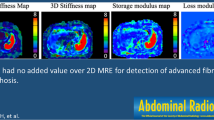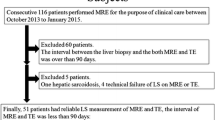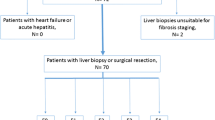Abstract
Purpose
The purpose of this study was to compare fibrosis seen on liver biopsy to MR elastography (MRE) stiffness measurements in normal controls and patients with abnormal transaminases and chronic liver disease.
Methods
The control group consisted of 22 healthy liver transplant donors who by definition had normal transaminases. The patient group (32 patients) was recruited from the Mayo Clinic Arizona hepatobiliary clinic over a 3-year span. All subjects underwent a liver biopsy as part of their evaluation and agreed to MRE within 35 days of biopsy. Non-parametric tests were used to compare the MRE-predicted liver fibrosis to the fibrosis noted on liver biopsy.
Results
Analysis included 54 subjects (32 patients with chronic liver disease and 22 healthy liver donor candidates). MRE median liver stiffness measurements increased per histologic liver fibrosis stage (one-way ANOVA p = 0.001), with significant correlation between increasing fibrosis stage and stiffness values. Median MRE for control group (2.13 kPa; mean = 2.3 ± 0.6 kPa) was significantly lower than for patient group (3.7 kPa; mean = 4.1 ± 2.1 kPa) (p = 0.003). Significantly, lower median stiffness was seen in zero-to-moderate (F0–2, n = 22) vs. severe fibrosis stages (F3–4, n = 10) 2.80 vs. 5.9 kPa, respectively (p < 0.05). Using a 3.7-kPa cut-off value, the predicted sensitivity and specificity for detecting F0–2 from F3–4 were 91% and 80%, respectively.
Conclusions
Our analysis supports previous findings that MRE is a non-invasive and effective method for detection and assessment of liver fibrosis, particularly for discrimination between F0–2 stages and F3–4 stages. MRE may represent a valuable tool to finely discern hepatic fibrosis non-invasively.





Similar content being viewed by others
References
Friedman SL, Rockey DC, Bissell DM (2007) Hepatic fibrosis 2006: report of the Third AASLD Single Topic Conference. Hepatology 45:242–249
Perrault J, McGill DB, Ott BJ, et al. (1978) Liver biopsy: complications in 1000 inpatients and outpatients. Gastroenterology 74:103–106
Thampanitchawong P, Piratvisuth T (1999) Liver biopsy: complications and risk factors. World J Gastroenterol 5:301–304
Afdhal NH, Nunes D (2004) Evaluation of liver fibrosis: a concise review. Am J Gastroenterol 99:1160–1174
Regev A, Berho M, Jeffers LJ, et al. (2002) Sampling error and intraobserver variation in liver biopsy in patients with chronic HCV infection. Am J Gastroenterol 97:2614–2618
Nishizaki T, Matsumata T, Kamakura T, et al. (1995) Significance of intraoperative measurement of liver consistency prior to hepatic resection. Hepato-gastroenterology 42:5–8
Yamanaka N, Okamoto E, Toyosaka A, et al. (1985) Consistency of human liver. J Surg Res 39:192–198
Yeh WC, Li PC, Jeng YM, et al. (2002) Elastic modulus measurements of human liver and correlation with pathology. Ultrasound Med Biol 28:467–474
Castera L, Vergniol J, Foucher J, et al. (2005) Prospective comparison of transient elastography, Fibrotest, APRI, and liver biopsy for the assessment of fibrosis in chronic hepatitis C. Gastroenterology 128:343–350
Ziol M, Handra-Luca A, Kettaneh A, et al. (2005) Noninvasive assessment of liver fibrosis by measurement of stiffness in patients with chronic hepatitis C. Hepatology 41:48–54
Huwart L, Sempoux C, Salameh N, et al. (2007) Liver fibrosis: noninvasive assessment with MR elastography versus aspartate aminotransferase-to-platelet ratio index. Radiology 245:458–466
Yin M, Talwalkar JA, Glaser KJ, et al. (2007) Assessment of hepatic fibrosis with magnetic resonance elastography. Clin Gastroenterol Hepatol 5(1207–1213):e2
Sandrin L, Fourquet B, Hasquenoph JM, et al. (2003) Transient elastography: a new noninvasive method for assessment of hepatic fibrosis. Ultrasound Med Biol 29:1705–1713
Yoshioka K, Kawabe N, Hashimoto S (2008) Transient elastography: applications and limitations. Hepatol Res. 38(11):1063–1068
Kwok R, Tse YK, Wong GL, et al. (2014) Systematic review with meta-analysis: non-invasive assessment of non-alcoholic fatty liver disease—the role of transient elastography and plasma cytokeratin-18 fragments. Aliment Pharmacol Ther 39(3):254–269. doi:10.1111/apt.12569
Goldschmidt I, Streckenbach C, Dingemann C, et al. (2013) Application and limitations of transient liver elastography in children. J Pediatr Gastroenterol Nutr 57(1):109–113
Lee CK, Perez-Atayde AR, Mitchell PD, et al. (2013) Serum biomarkers and transient elastography as predictors of advanced liver fibrosis in a United States cohort: the Boston children’s hospital experience. J Pediatr 163(4):1058.e2–1064.e2. doi:10.1016/j.jpeds.2013.04.044
Talwalkar JA (2008) Elastography for detecting hepatic fibrosis: options and considerations. Gastroenterology 135:299–302
Muthupillai R, Lomas DJ, Rossman PJ, et al. (1995) Magnetic resonance elastography by direct visualization of propagating acoustic strain waves. Science 269:1854–1857
(1994) Intraobserver and interobserver variations in liver biopsy interpretation in patients with chronic hepatitis C. The French METAVIR Cooperative Study Group. Hepatology 20:15–20
Brunt EM (1999) Nonalcoholic steatohepatitis (NASH): further expansion of this clinical entity? Liver 19:263–264
Batts KP, Ludwig J (1995) Chronic hepatitis. An update on terminology and reporting. Am J Surg Pathol 19:1409–1417
Dunn OJ (1964) Multiple comparisons using rank sums. Technometrics 6:241–245
Kim BH, Lee JM, Lee YJ, et al. (2011) MR elastography for noninvasive assessment of hepatic fibrosis: experience from a tertiary center in Asia. J Magn Reson Imaging 34(5):1110–1116
Ichikawa S, Motosugi U, Ichikawa T, et al. (2012) Magnetic resonance elastography for staging liver fibrosis in chronic hepatitis C. Magn Reson Med Sci 11(4):291–297
Venkatesh SK, Wang G, Lim SG, Wee A (2014) Magnetic resonance elastography for the detection and staging of liver fibrosis in chronic hepatitis B. Eur Radiol 24(1):70–78. doi:10.1007/s00330-013-2978-8
Goldstein NS, Hastah F, Galan MV, Gordon SC (2005) Fibrosis heterogeneity in nonalcoholic steatohepatitis and hepatitis C virus needle core biopsy specimens. Am J Clin Pathol 123(3):382–387
Conflict of interest
None.
Author information
Authors and Affiliations
Corresponding author
Rights and permissions
About this article
Cite this article
Batheja, M., Vargas, H., Silva, A.M. et al. Magnetic resonance elastography (MRE) in assessing hepatic fibrosis: performance in a cohort of patients with histological data. Abdom Imaging 40, 760–765 (2015). https://doi.org/10.1007/s00261-014-0321-8
Published:
Issue Date:
DOI: https://doi.org/10.1007/s00261-014-0321-8




